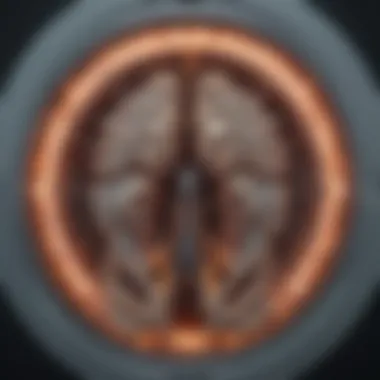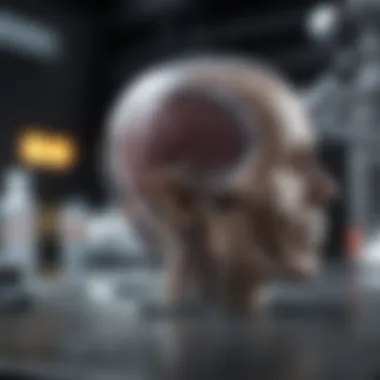Exploring the Importance of Medical Imaging in Healthcare


Intro
Medical imaging plays a vital role in modern healthcare. It provides crucial tools for diagnosing and treating diseases. This field uses various technologies to create visual representations of the interior of a body for clinical analysis. Each modality, from X-rays to magnetic resonance imaging (MRI), serves a distinct purpose. This article will explore these methodologies, their significance, and the applications in medical settings.
Research Overview
Summary of Key Findings
The significant contributions of medical imaging to healthcare are evident in several key areas:
- Diagnosis: Accurate detection of diseases such as cancer and fractures.
- Treatment Planning: Guidance for surgeons in procedures like tumor removal.
- Monitoring Progress: Evaluating the effectiveness of treatments over time.
Background and Context
The evolution of medical imaging started in the late 19th century with Wilhelm Röntgen's discovery of X-rays. Over the decades, additional modalities like computed tomography (CT) and nuclear medicine imaging were developed. These advancements have exponentially increased diagnostic capability, allowing for non-invasive insights into human anatomy.
Methodology
Experimental Design
The design of studies in medical imaging varies based on the modality utilized. It often involves control and experimental groups for comparing outcomes after imaging procedures. This approach helps establish the efficacy of different imaging techniques.
Data Collection Techniques
Data is collected through various means depending on the imaging technique:
- Radiography: Involves manual image processing and analysis by radiologists.
- MRI: Uses magnetic fields and radio waves to produce detailed images.
- Positron Emission Tomography (PET): Involves the injection of tracer compounds to visualize metabolic activity.
"Medical imaging is not just about seeing; it's about understanding the information and providing better care."
The evolution and integration of these technologies underscore the importance of medical imaging. As the field progresses, ethical considerations and future advancements remain critical discussions for professionals in healthcare. Keeping these elements in mind enhances the comprehension of medical imaging's role and its impact on patient outcomes.
Defining Medical Imaging
Medical imaging plays a pivotal role in modern healthcare. Defining it accurately is critical for understanding its functions, benefits, and implications within the medical field. It encompasses various techniques that enable visualization of the interior of a body for clinical analysis and medical intervention. The primary goal is to diagnose diseases and monitor health conditions. Moreover, medical imaging serves as a foundation for recent advancements in treatment protocols, ensuring that patient care is more effective and efficient.
The Concept of Medical Imaging
Medical imaging refers to the methods used to create visual representations of the body’s interior. These techniques are essential for both diagnostic purposes and therapeutic processes. Common modalities include X-ray imaging, MRI, CT scans, and ultrasound, among others. Each modality has its own strengths, weaknesses, and specific applications. For instance, X-rays are widely used for bone fractures, while MRI is more effective for soft tissue evaluation. The diversity in imaging methods allows healthcare professionals to select the most appropriate one based on the clinical scenario.
Alongside diagnostic applications, medical imaging is also significant for planning and guiding treatment. In surgical procedures, imaging can assist in precisely locating tumors or other critical structures. This precision contributes to increased patient safety and improved surgical outcomes. Furthermore, real-time imaging techniques like ultrasound allow for immediate assessment during procedures, making them invaluable.
Historical Context
The journey of medical imaging traces back to the discovery of X-rays by Wilhelm Conrad Röntgen in 1895. This groundbreaking advancement marked the beginning of imaging in medicine, providing a glimpse into the human body without the need for invasive procedures. Over the decades, further innovations emerged:
- Computed Tomography (CT) was introduced in the 1970s, providing cross-sectional images and revolutionizing the way clinicians could analyze internal structures.
- Magnetic Resonance Imaging (MRI) followed in the 1980s, utilizing magnetic fields to offer detailed images, particularly of soft tissues.
- Ultrasound technology also gained acceptance during this same era, promising a non-invasive way to observe fetal development and other internal functions.
As each new technology emerged, the medical field expanded its diagnostic capabilities and improved patient outcomes. The evolution of medical imaging has accelerated significantly in recent years, integrating advanced software and machine learning techniques to enhance accuracy and efficiency. Today, imaging is not viewed solely as a diagnostic tool; it is an essential component of personalized medicine, paving the way for tailored treatment approaches based on detailed patient data.
“The evolution of medical imaging technologies is a testament to the relentless pursuit of improved patient care and outcomes.”
Understanding the fundamental aspects of medical imaging, its history, and its relevance today is crucial for students, researchers, and healthcare professionals alike. It sets the stage for exploring various imaging modalities and their applications in subsequent sections.
Key Technologies in Medical Imaging
Medical imaging represents a crucial element in contemporary healthcare. The technologies described below form the foundation of diagnostic capabilities, directly influencing treatment approaches and patient outcomes. Each modality has distinct features, advantages, and specific clinical applications, making them valuable tools for health professionals.


X-ray Imaging
X-ray imaging is one of the oldest and most commonly used forms of medical imaging. It functions by passing a controlled amount of radiation through the body, capturing images of the internal structures. The primary benefit of X-ray imaging is its ability to quickly visualize bones and certain tissues, making it invaluable for identifying fractures and infections.
Despite its advantages, X-ray imaging involves exposure to radiation, even in small amounts. This raises questions regarding its frequency of use, especially for vulnerable populations like pregnant women and children. However, with advances in technology, the doses have significantly decreased, minimizing risks while maximizing diagnostic yield.
Computed Tomography (CT)
Computed Tomography, or CT, takes medical imaging a step further. This technology combines multiple X-ray images taken from different angles and uses computer processing to create cross-sectional images of bones, blood vessels, and soft tissues. CT scans provide more detailed information than standard X-ray imaging, allowing for better diagnosis of conditions like tumors, internal bleeding, and organ diseases.
However, the CT scan comes with higher radiation exposure compared to traditional X-rays. Therefore, it's crucial for healthcare providers to weigh the benefits against the risks when recommending this imaging modality. Less invasive than exploratory surgery, CT remains a powerful tool in modern medicine.
Magnetic Resonance Imaging (MRI)
Magnetic Resonance Imaging (MRI) utilizes strong magnetic fields and radio waves to generate detailed images of the organs and tissues within the body. This technology is particularly notable for its ability to provide exceptional contrast between different soft tissues, making it effective for neurological, musculoskeletal, and cardiovascular assessments. MRI does not involve ionizing radiation, which makes it safer over repeated examinations.
One drawback is the time required for an MRI scan compared to X-ray or CT scans. Patients must remain still for up to an hour, which may be challenging for some. Additionally, the cost of MRI exams tends to be higher, which can limit accessibility in some settings.
Ultrasound Imaging
Ultrasound imaging employs sound waves to create images of the inside of the body. It is especially well-regarded for its utility in monitoring pregnancies and evaluating abdominal organs. One of the key advantages of ultrasound is that it is safe and does not use radiation. This makes it a preferred method for assessing conditions in sensitive populations, such as expectant mothers.
Ultrasound imaging is also portable and can be conducted at the point of care, offering real-time imaging. On the downside, its effectiveness can be limited by factors such as body habitus and operator experience, which can affect image quality.
Positron Emission Tomography (PET)
Positron Emission Tomography (PET) is an advanced imaging technique that allows for the visualization of metabolic processes in the body. By using a small amount of radioactive material, PET scans can detect abnormalities at a cellular level. This makes it particularly useful in cancer diagnosis and monitoring. PET scans can identify changes in cellular metabolism before structural changes occur in tissues, allowing for early detection of diseases.
However, PET is often used in conjunction with CT or MRI to enhance accuracy in localization and characterization of diseases. The radioactive tracers used in PET scans have limited duration, which may impose timing constraints on scheduling these exams.
Applications of Medical Imaging
Medical imaging serves as a cornerstone in modern healthcare, profoundly influencing both diagnosis and treatment. Understanding the diverse applications of medical imaging is crucial for appreciating its role in patient care. These applications can be broadly categorized into three key areas: diagnostic purposes, therapeutic guidance, and research applications. Each area highlights the multifaceted nature of medical imaging and its significant benefits in clinical practice, ensuring better outcomes for patients.
Diagnostic Purposes
One of the primary applications of medical imaging is in diagnostics. Medical imaging techniques enable healthcare professionals to visualize the internal structures of the body without the need for invasive procedures. This ability is essential for identifying conditions such as fractures, tumors, and organ abnormalities. Techniques like X-ray and MRI provide distinct advantages in diagnostics.
- X-ray Imaging: X-rays are typically the first step in examining bone fractures and infections. Their ability to produce quick images helps in making prompt medical decisions.
- MRI and CT Scans: For soft tissue examination, MRI and CT scans offer high-resolution images. They are particularly effective in diagnosing conditions like brain tumors or internal bleeding.
The speed and accuracy of these imaging techniques not only enhance diagnostic precision but also improve patient management by facilitating timely treatment decisions.
Therapeutic Guidance
Medical imaging also plays a vital role in therapeutic guidance. Beyond diagnosis, it aids clinicians in planning and executing treatment strategies. For instance, during surgery, real-time imaging helps surgeons navigate complex anatomy and enhances precision. Techniques such as fluoroscopy and ultrasound are often utilized in this context.
- Fluoroscopy: It provides continuous real-time images, allowing physicians to monitor the position of instruments as they guide them to the treatment area.
- Ultrasound Imaging: In procedures like biopsies, ultrasound helps in locating the precise area to target while minimizing damage to surrounding tissues.
This integration of imaging into therapeutic strategies not only improves outcomes but also reduces complications, helping clinicians to tailor treatments effectively.
Research Applications
Lastly, medical imaging is indispensable in research applications. It allows for the exploration of illness mechanisms, the development of new treatment modalities, and the testing of drug efficacy. Researchers use advanced imaging techniques to understand disease progression and potential interventions more clearly. For example:
- Positron Emission Tomography (PET): PET scans are instrumental in cancer research, providing insights into metabolic processes related to tumor growth and treatment response.
- Functional MRI (fMRI): In neuroscience, fMRI is utilized to study brain activity in response to various stimuli, advancing knowledge on neurological disorders.
Investigating these areas not only advances scientific knowledge but also has tangible benefits for patient care in clinical settings.
"Medical imaging not only transforms diagnosis but also influences treatment pathways, advancing the overall quality of care provided to patients."


The evolving landscape of medical imaging continues to expand its capabilities, underpinning the significance of its applications in healthcare. As technology progresses, the effectiveness and sophistication of these imaging modalities will likely increase further.
Interpreting Medical Images
Interpreting medical images is a crucial step in the diagnostic process within modern healthcare. Accurate interpretation is essential as it influences patient outcomes and treatment decisions. Various imaging modalities create detailed insights into a patient's condition, but these images require skilled professionals to analyze them properly. This section delves into the significant role radiologists play in interpreting images, along with technological aids that enhance this process.
Role of Radiologists
Radiologists are the specialists trained specifically to read and interpret medical images. Their education includes years of study and residency programs that focus on various imaging modalities. They have a deep understanding of human anatomy and pathology. This foundation allows them to identify abnormalities that may not be immediately visible.
The significance of a radiologist's expertise cannot be overstated. They provide detailed reports which guide physicians in determining appropriate treatment strategies. For instance, in detecting tumors through MRI scans, a radiologist assesses intricate details that could indicate malignancy. This careful analysis is vital in early detection and timely intervention, which can significantly affect patient prognosis.
Moreover, the collaborative relationship between radiologists and referring physicians is essential. It ensures that imaging findings are integrated into comprehensive patient care plans. Regular communication enhances the understanding of imaging results, permitting tailored treatment options based on individual needs.
Technological Aids in Interpretation
Advancements in technology have had a profound impact on the interpretation of medical images. There are several aids that assist radiologists in providing accurate and timely assessments:
- Computer-Aided Detection (CAD): This tool helps in identifying potential areas of concern in the images. It's especially common in mammography, offering a second opinion to the radiologist's interpretation.
- Artificial Intelligence (AI): The integration of AI models has shown promise in automating parts of the analysis. AI can detect patterns and anomalies at speeds and accuracies that surpass traditional methods, supporting radiologists in making informed decisions.
- 3D Imaging: This technology provides a more complete view of anatomical structures, allowing radiologists to assess complex cases effectively.
While these tools bolster the interpretation process, reliance solely on technology is not without caution. Technology should enhance, not replace, the critical judgment and expertise of trained professionals. The combination of human intelligence and technological advancements creates a more solid foundation for accurate medical imaging interpretation.
Effective interpretation of medical images is not just about identifying problems; it is about understanding their implications for patient health and guiding further steps in care.
In summary, interpreting medical images is a collaborative and technologically enriched process that plays an essential role in healthcare. Radiologists are indispensable professionals whose expertise ensures that imaging findings translate into successful patient care strategies.
Ethical Considerations in Medical Imaging
In the realm of medical imaging, ethical considerations emerge as a fundamental aspect that influences both practice and patient care. These considerations play a crucial role in ensuring that the benefits of imaging technologies do not come at the cost of the patient’s rights or safety. There are several key elements within this subject, including patient consent, autonomy, and safety measures regarding radiation exposure. Addressing these ethical issues ensures that medical imaging remains a responsible and trusted tool in healthcare.
Patient Consent and Autonomy
Informed consent is an essential component of medical practice, particularly in medical imaging. Patients must understand the purpose of the imaging procedure, how it will be performed, and any potential risks involved. This knowledge empowers patients to make educated decisions regarding their healthcare.
The principle of autonomy is central to patient consent. Respecting a patient's right to choose whether or not to undergo a particular imaging test is critical. Some individuals may decline imaging for various personal reasons. Their decisions must be honored without pressure or coercion from medical professionals. The role of healthcare providers is to adequately inform patients while respecting their choices, thereby promoting a more collaborative healthcare experience.
Radiation Safety
Radiation safety is another vital concern in medical imaging. Many imaging modalities, particularly X-rays and CT scans, expose patients to ionizing radiation. It is the responsibility of healthcare professionals to minimize these risks while still providing essential diagnostic information.
Health care providers should adhere to the ALARA principle, which stands for "As Low As Reasonably Achievable." This principle encourages the reduction of radiation exposure to patients at every opportunity during imaging procedures.
Furthermore, ongoing education and training for radiology staff are crucial for implementing stringent safety protocols.
- Use protective lead shields where appropriate.
- Ensure proper calibration of imaging devices to avoid overexposure.
- Monitor doses of radiation for patients, particularly those undergoing multiple scans over time.
Adhering to these practices contributes to a safer imaging environment while minimizing the long-term health risks associated with radiation exposure.
Informed consent and patient safety are the cornerstones of ethical medical imaging practices.
Effective communication of risks and benefits remains paramount. Healthcare professionals should foster open dialogues that allow patients to ask questions or express concerns about imaging procedures. By maintaining transparency and patient engagement, the healthcare industry reinforces a commitment to ethical practices in medical imaging.
Challenges in Medical Imaging
The field of medical imaging faces several challenges that can hinder its effectiveness and accessibility. Understanding these obstacles is vital for advancing medical imaging technology and ensuring that it serves its intended purpose in healthcare. Various aspects such as access to services, costs, technology limitations, and regulatory hurdles contribute to the complexities of this field.
Access to Imaging Services
Access to imaging services is a crucial barrier in many healthcare systems. Despite the benefits of advanced imaging techniques like MRI and CT scans, these services are not uniformly available to all populations. Rural areas, in particular, often struggle with limited access to imaging centers, resulting in delayed diagnoses and treatments. Additionally, disparities exist based on socioeconomic status, where individuals from lower-income backgrounds may lack insurance or financial means to afford necessary scans.


Moreover, patient flow and utilization rates are often suboptimal in certain facilities. This can stem from a shortage of trained professionals in imaging technology, leading to increased wait times for appointments or inadequate interpretation of results. The challenge is thus multifaceted, involving geographical, financial, and educational elements that affect accessibility.
Cost Implications
The cost of medical imaging is another significant challenge. Imaging technologies can be expensive, not only regarding the initial investment in equipment but also the ongoing operational costs. These expenses can lead to high prices for patients, which may discourage them from seeking necessary diagnostic tests.
Health insurance can alleviate some of these financial pressures; however, not all imaging procedures are fully covered. Patients may find themselves facing out-of-pocket expenses, impacting their decision to pursue imaging services. Furthermore, the costs of imaging can vary significantly based on the facility, geographical location, and the type of scan.
In addition, the high costs associated with advanced imaging techniques can lead institutions to prioritize shorter-term financial viability over patient care. This situation can create a tension between offering necessary services and managing the healthcare budget effectively.
"The accessibility and cost prevalence of imaging services are intertwined challenges that impact patient care quality and outcomes."
As medical imaging continues to evolve, addressing the challenges of access and cost will be critical. Doing so will not only enhance the reach of imaging services but will also ensure that advancements in technology translate into improved patient outcomes.
Future Directions in Medical Imaging
The landscape of medical imaging is evolving rapidly, shaped by continuous technological advancements and changing healthcare demands. Awareness of future directions in medical imaging is crucial. This section outlines how upcoming trends can influence diagnostics, patient care, and healthcare delivery.
Advancements in Technology
Medical imaging technology is advancing at a remarkable pace. Innovations such as 3D imaging, portable ultrasound devices, and enhanced imaging methods promise improved diagnostics. Furthermore, techniques like functional MRI (fMRI) provide real-time insights into brain activity. These advancements lead to higher resolution images, quicker processing times, and the ability to visualize complex structures more accurately.
Some notable advancements include:
- Hybrid Imaging: Technologies such as PET-CT and SPECT-CT merge multiple imaging modalities, providing comprehensive insights into physiological and anatomical features.
- Spectral Imaging: This uses multiple wavelengths to create detailed images. It can identify tissues with high accuracy by distinguishing between different material compositions.
- Portable Imaging Techniques: With portable devices, imaging can occur outside of traditional settings, increasing accessibility for various patient populations, particularly in remote areas.
These technological advancements not only improve imaging efficacy but also enhance patient experiences by reducing scan times and increasing diagnostic accuracy.
Integration with Artificial Intelligence
The integration of artificial intelligence (AI) into medical imaging is transformative. AI algorithms can analyze images to detect abnormalities faster than human specialists. For instance, deep learning approaches are applied to automated image interpretation, identifying conditions such as tumors or fractures with notable accuracy.
Some significant impacts include:
- Increased Efficiency: AI streamlines workflows in radiology departments, allowing radiologists to focus on complex cases that require human expertise.
- Standardization of Interpretations: AI helps to maintain consistency across image interpretations, reducing variability that may arise from different human readers.
- Enhanced Predictive Analytics: By analyzing historical imaging data, AI can assist in predicting disease progression, allowing for early intervention.
The amalgamation of AI and medical imaging not only augments the capabilities of healthcare professionals but also initiates a new era of precision medicine.
Impact on Personalized Medicine
Personalized medicine tailors treatment based on individual patient characteristics. Medical imaging plays a foundational role in this approach by providing detailed insights into a patient’s unique anatomical and physiological makeup. Advancements in imaging technology contribute to refining treatment strategies, enhancing patient outcomes.
Key effects of medical imaging on personalized medicine include:
- Targeted Treatments: With advanced imaging, clinicians can visualize the exact location and nature of a disease, enabling more precise treatment strategies, such as targeted radiotherapy.
- Monitoring Treatment Efficacy: Continuous imaging allows for real-time monitoring of how well a treatment is working, leading to quicker adjustments if necessary.
- Patient Stratification: Imaging helps to categorize patients based on their specific imaging profiles, leading to more appropriate treatment selection.
As the reliance on personalized medicine grows, the integration of advanced imaging techniques becomes increasingly essential.
The future of medical imaging is not just about new technologies; it's also about redefining how care is delivered and tailored to individual patient needs.
Epilogue
Medical imaging plays a critical role in the landscape of modern healthcare. It allows for precise diagnosis and treatment planning, which significantly enhances patient outcomes. In this article, we explored various imaging modalities, including X-ray, CT, MRI, ultrasound, and PET. Each of these technologies serves unique functions, contributing to an accurate understanding of a patient's medical status.
The importance of medical imaging extends beyond diagnostics. It aids in therapeutic guidance, helping clinicians decide the best course of action based on visual evidence. For researchers, it offers a window into the complexities of human physiology, pushing the boundaries of medical knowledge.
Summarizing the Importance of Medical Imaging
Medical imaging should be regarded as a cornerstone of contemporary medicine. Its benefits are manifold:
- Enhanced Diagnostics: Imaging technologies allow for non-invasive examinations, leading to quicker and more accurate diagnoses.
- Guiding Treatment: Radiologists provide insights that are crucial for developing effective treatment plans and monitoring progress.
- Research Insights: Advanced imaging methods support experimental studies, facilitating breakthroughs in understanding diseases and developing new therapies.
The ethical considerations surrounding medical imaging, particularly regarding patient consent and radiation exposure, must also be highlighted. Clinicians should remain vigilant about these issues, ensuring a balance between diagnostic benefits and ethical responsibility.
Moreover, the future of medical imaging looks promising with advancements in technology and integration with artificial intelligence. This can lead to improved accuracy and personalized medicine, tailoring treatments to individual patient needs.







